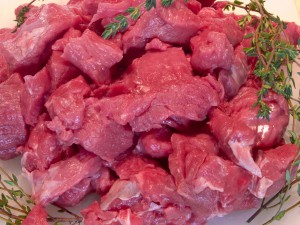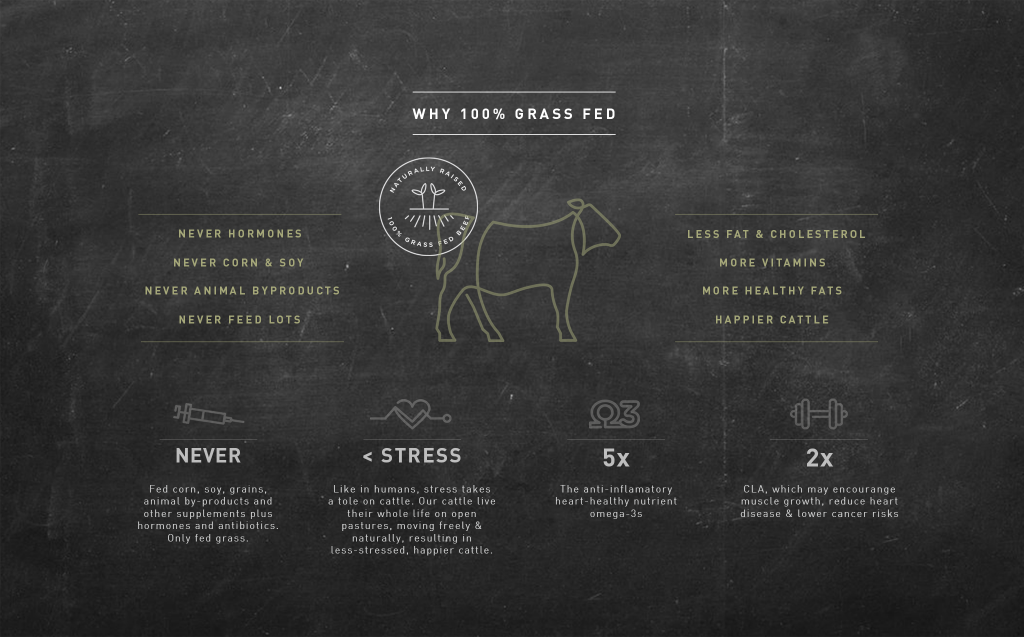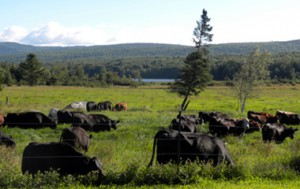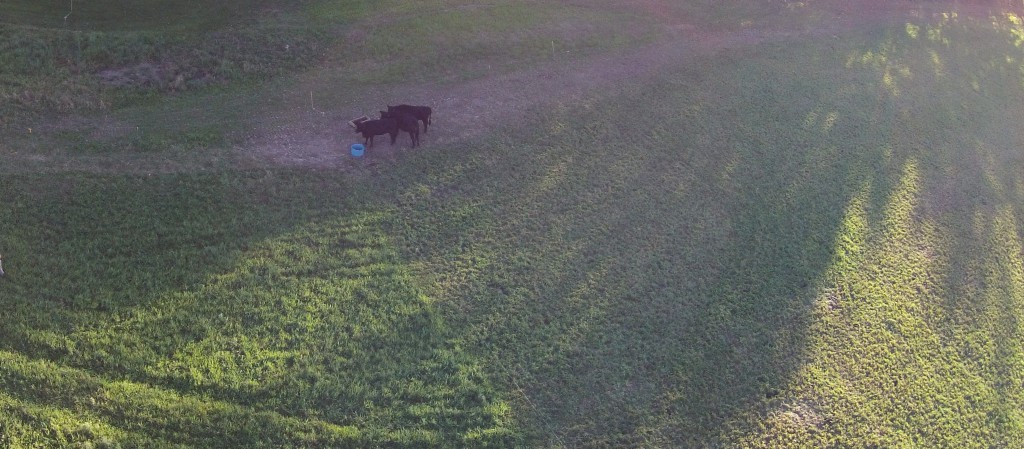If there was an ingredient list for grass fed meat what would it say? As people ask what is in grass fed meat I wonder what I would put on an ingredient list. This would all depend on what the animal ate. Our beef cows simply eat fresh green grass as we move them daily to new pasture. We give them clean water and an all natural mineral supplement if they need anything more. So the ingredient list for our beef may read: Grass, water, sunshine, fresh air and all natural minerals. This is simply the best “ingredient list” for beef that we have found.
Taste and Texture

If we follow the proper protocol for raising beef there is more to it than what would be on an ingredient label. I was never thrilled about eating steak and beef roast as it didn’t taste all that great unless you doctored it up with seasonings and sauces and tenderized it. However when I discovered totally grass fed beef I was amazed at the difference. I would never go back to conventional grain fed beef again. We don’t do anything special as far as seasonings and the only treatment for tenderizing the meat is giving it adequate hanging time during the butchering process yet it is the best tasting and most tender beef we have ever had.
Nutrition
Not only does our meat taste good it has many beneficial nutrients in it. Two of the biggest ones are a balanced omega 3 to 6 ratio and higher levels of Conjugated linoleic acid (CLA). Grain fattened cattle are higher in omega 6 but low in omega 3 where grass fed has more omega 3 which is what your body needs. The CLA in grass fed beef has been found to be important in fighting ailments like cancer and heart disease. The overall mineral content has been found to be higher in grass fed meat such as calcium, magnesium, and potassium. When looking at the research I have found that when I compare grass fed beef to grain fed in side by side comparison there is a significant difference in the overall nutrient content.

Not all grass fed beef is the same.
If we are going to look at what is in grass fed beef it is important to understand that there are different methods of raising what is labeled as “grass fed beef” and the different methods produce different characteristics in the meat. I will give you the basic methods that are used.
- Grass fed and grain finished. The cattle live most of their lives on grass however the last 100 days or so they are fed grains to fatten them up and this reduces the grass fed benefits of the meat. Even certified organic meat can be done this way as long as the grain is organic. Unfortunately this is the most common method currently used for grass fed beef in the commercial farming practice.
- Grass fed without pasture. Believe it or not a lot of so called grass fed beef is grown with minimal exposure to pasture and the pasture they do get has very little grass growing on it. If there are too many animals the pasture gets eaten down to nothing and the cattle are fed dry hay to supplement for the poor pasture conditions. This method also lowers the nutrient value of the meat since they don’t get enough fresh nutrient rich grass.
- Grass fed with grain and/or grain byproducts. Because many beef producers focus on quantity rather than quality they feed cheap feed additives to the cows. These byproducts are typically grain that has been processed and what is left is fed to beef cows. Often the byproduct has had the starch removed. This too diminishes the quality of the meat.
- Totally grass fed and finished. This is the method of giving a cow the one thing they were designed to thrive on and that is grass. I have said often that a cow is a four stomach herbivore that is designed to reap as much nutrition from grass as possible. Keep in mind that in many climates such as ours in Northern Pennsylvania there are times when cows will need to be supplemented with hay since there isn’t green lush grass year round like in winter or severe drought. The best farmers raising grass fed beef keep their animals on high quality grass as much as possible by managing the pastures so that the grass has time to grow before being grazed.

Notice the line where the cows have grazed and where they haven’t. They get moved to the new grass each day. Even though this was a very dry time they still get fresh green grass.
Get to know your farmer.
We are seeing more and more meat in grocery stores labeled as grass fed and organic however it is really hard to know what is in grass fed beef that is in the stores. Much of it is imported from other countries since the US beef supply is dominantly grain fed. The number of farmers implementing 100% grass fed beef is growing and hopefully you will be able to find one near you. If you can’t find a reputable local source there are a few online suppliers that will ship to you but be careful as to how good their standards are. I have found a few that I believe to have the quality I demand and you can see more about them at our where to find grass fed meat page. You can also see what we offer in our local area at our store.
Thanks for stopping by and if you have any questions or comments about grass fed beef please leave them below and I will get back to you.
God bless!
That’s a nice way to grow a herd. My friend used to work in a butcher house in Australia as a boner. I saw their line of work and it is really exhausting having to cut those monster size meats to cater every cut orders. He said, the best meat is from a cow who is fed without having to scour the grassland. Just fed inside a secure cage with little to no lateral movement at all. Just let the cow fatten up. He says, it gives up a very soft kind of meat which just melts in the mouth. In your opinion, is that true?
Thanks for your comment Paul! What your friend describes as an ideal way to grow beef doesn’t sound very animal friendly. I know that when I look at an animal in confinement it looks no where near as happy and healthy as mine do on good pasture. If we don’t get fresh air, exercise, good food and sunshine we are not healthy so if the animal isn’t getting what it needs it may seem like you are getting good meat but in the end I can’t imagine it it healthy nutrient dense meat. Interesting observation you give here Paul. Thanks and God bless!
Grass fed beef. I have my plate fork and knife ready! I grew up on grass fed beef. That was quite some time ago. Your information is quite thorough on the differences between grass and grain fed. Store bought beef just does not compare to the flavor and goodness of grass-fed. If I lived in Pennsylvania I certainly would be stopping by for a chit chat and to purchase a side of beef. Thanks for your great website and content.
Yes, there is a difference for sure. I enjoy talking with folks about the goodness of naturally raised meat and how good it is for us. Hope you have a good source near you. Thanks for the comment!
wow, we really don’t know what are we eating,e?
Many things to learn ,for me all pieces of meat look the same till now:))
Nice to learn how to recognize the good one. Thanks for your helpful information and I am sure is good for all people to be more helpful what are we eating:))))
what you think is safer? chicken, beef or pork?
thank you and have a nice day
We didn’t pay any attention to what we ate untill the last few years when we started learning about what real food is. Once we experienced good quality food we were amazed at how bad most food is in the stores. As far as what kind of meat is safer I would have to say that all meat can be safe if it is grown the right way in which it was designed to be. Not altered with chemicals and unnatural feed. Get to know the source of your food to know what is in it. Thanks for the comment.
I am from Vermont and that is the way we do it around here. I don’t raise them anymore myself but, lots of people around here do and they do it the same way as you do. I think it is the only way to go. I know I would rather have grass fed cow meat any day.
That is interesting and great that grass fed meat is common in Vermont. My hope and prayer is that it will get to be more common everywhere so good meat is accessible and affordable to everyone. Glad you see the differnce like so many have. Thanks for your input on this!
Hi,
I’ve been told that grass fed beef is much better in taste and nutrition. But it’s not easy to find real grass fed beef. And even sometimes I saw some grass fed beef being sold in store, I can’t tell which one is good and which one is not. Any suggestion how we can know which proper grass fed beef we should buy?
Thanks
Louis
Hi Louis! There is getting to be more and more grass fed beef in stores however the concern is that most of the meat labeled grass fed in stores is imported from other countries and it is hard to say how safe it is. The very best way to know what your getting is to buy local from someone you can trust and if that isn’t possible check out a few places on line that will ship to you. I have info on those at our page on “where to find grass fed meat“. Hope this helps!
Hi there,
I have long been eating grass fed beef for its superior flavour and texture. I live in Australia where it is quite widely available. A lot of farmers also use molasses and ‘sweet grass’ which is meant to improve the meat taste even further. How long is best for adequate hanging time?
Thanks for an informative article, Kris
Hi Kris! I would be interested in knowing more about what sweet grass is and how it is used. That is great that good grass fed beef is widely available in Australia and that is my desire that good quality meat would be avaliable everywhere on a local level. As far as hanging time we try to aim for two weeks and that seems to get us nice tender beef. Thanks for stopping by Kris!
About 6 months ago, I started a low-carb, high-fat diet and totally changed the way I eat. I find it so difficult to find grass-fed beef in my area. I can find it in the store from time to time, but you really got to pay for it. I don’t care. It is worth it. I don’t want all of the hormones or anti-biotics. I just want real meat from healthy cows. I have been able to find butter from grass fed cows and it is amazing tasting. It is certainly worth the extra cost.
That is interesting how you changed your diet. What kind of changes have you seen in your health? I would be interested in hearing from you in another 6 months and see how you are doing. Hope you find a good local source for your healthy meat and other foods. Thanks for your comment Wendy!
Wendy, I also switched to grass-fed butter, specifically Amish butter which I purchase in the same local farm I buy my grass-fed beef steak cuts. My friends praise the butter as the best they ever had, and I love spreading it on my steaks and morning bacon pancakes. I feel this is decadent, but the increased CLA helps me feel better about my choices. Thanks for the article.
Everything is better when it comes from grass fed/pastured animals. Is the butter you get from raw milk or pasteurized. I try to get raw milk butter but it isn’t easy. Thanks for stopping by and hope to hear from you again.